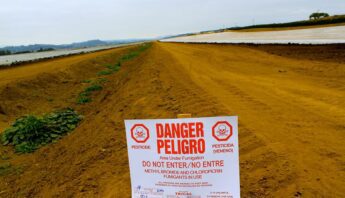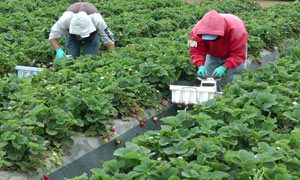For immediate release, July 10, 2008
Contact: Pesticide Action Network North America
Susan Kegley, PhD (510-759-9397) or
Brian Hill, PhD (510-289-4329)
Chela Vazquez, PhD (415-981-6205 ext. 317)
Steve Scholl-Buckwald, PhD (415-203-4455)
Improvements leave communities and workers at risk for continued poisonings
Farmworker, community and environmental health groups call on Agency to take stronger action
Washington, DC – After three years of deliberation, US Environmental Protection Agency today proposed new rules for five highly toxic fumigant pesticides.* Environmental health, community and farmworker groups say the rules, while substantially better than the past, still fall short of protecting people, workers and the environment.
“So many people, including my family and friends, have been poisoned by these pesticides. I was hoping EPA would do more to protect farmworkers and rural communities,” says Teresa DeAnda, a resident of Earlimart, CA from Californians for Pesticide Reform.
Among the most toxic chemicals used in agriculture today, fumigants are gases or liquids that are injected or dripped into the soil to sterilize a field before planting. Even with plastic tarps on the soil, fumigants escape from the soil and drift through the air into schools, homes, parks and playgrounds. Strawberries, tomatoes, peppers, carrots and potatoes are some of the major crops for which fumigant use is high.
Rural communities and farmworkers from across the nation, and especially in California, Florida, Washington and Texas, had hoped that EPA would use this opportunity to help move American agriculture to safe, secure and sustainable pest management technologies. "Fumigants such as methyl bromide should not be used under any circumstances," says Shelley Davis of Farmworker Justice Fund. "This product has been linked to high risk of birth defects and nervous system damage."
The most significant changes proposed by EPA require "buffer zones" — farmers must leave from 25 feet to half a mile between the fumigated field and homes, schools, and other places where people might be. Other new rules include notification at least 48 hours before fumigation, posting warning signs around the buffer areas and monitoring gas levels before and during worker reentry to fields. For the first time workers who cut open tarps after fumigation will be considered "handlers" and required to wear protective breathing masks.
The buffer zones for these five fumigants are intended to lower the amount of fumigants in air that drifts away from the application site. They are an improvement over current use patterns that — except for Telone, another fumigant — require no buffer zones to protect people. However, the size of EPA’s buffers are "scenario based" and, under certain conditions, can be waived. Thus the protection of EPA’s new buffer zones may be too little to prevent acute poisonings. In September 2007, 121 workers in Nevada more than ¼ mile from a fumigation site were rushed to the hospital because of fumigant drift. Lesser drift incidents often go unnoticed because people don't know why they are feeling sick.
“Fumigation is an antiquated technology that relies on killing everything in the soil,” said Dr. Susan Kegley, Senior Scientist at Pesticide Action Network. “EPA has made some real progress with buffer zones, notification, posting and monitoring – they actually heard some of what we've been telling them. And they've put the burden back on manufacturers for responsible handling of these highly toxic chemicals. But it’s time to help farmers move beyond this ‘scorched earth’ approach. The new rules are a small start.”
"With state and federal budgets stretched so far, where is the money to come from for enforcement and for the training they are going to require?" asks Lynda Uvari, a resident of Ventura, California where strawberry fields dominate the landscape and run right up to her backyard. "If it is up to the pesticide registrants, who is going to make sure that the registrants are going to do it?"
Jeannie Economos, Pesticide Health and Safety Coordinator with the Farmworker Association of Florida, adds: “We appreciate the mitigation measures that EPA has taken. However, we foresee that enforcement could still be problematic. Any exposure of a worker or a farmworker community is a risk that we shouldn’t take. The best solution is to ban fumigants altogether."
"The combination of posting, advance notification of state agencies, and buffer zones around fields will substantially reduce the number of fumigant poisonings," observes Dr. Brian Hill, science department director at Pesticide Action Network, "and when something does go wrong, communities and emergency personnel will be much better prepared to respond."
"Clearly," Kegley observes, "major accidents, continued exposure, and technical critiques are not enough to get rid of fumigation. During the entire three years of this fumigant assessment process, there’s been a tendency in EPA's analyses to whittle away at established 'safety factors' designed to protect communities. We're guardedly optimistic that the new rules are a step toward protecting public health, but the final result represents a continued failure to take agriculture off the pesticide treadmill."
###
For more information
- Dr. Susan Kegley, senior scientist, Pesticide Action Network North America 510-759-9397, skegley@panna.org
- Dr. Brian Hill, staff scientist, Pesticide Action Network North America 510 289-4329, bhill@panna.org
- Teresa DeAnda, Central Valley Coordinator, Californians for Pesticide Reform, 661-304-4080
- Lynda Uvari, founding board member of Community and Children’s Advocates Against Pesticide Poisoning, 805-701-8154, ccaapp4u@yahoo.com
- Jeannie Economos, Pesticide Health and Safety Coordinator, Farmworker Association of Florida, 407-886-5151, Farmworkerassoc@aol.com
- Shelley Davis, Deputy Director, Farmworker Justice Fund, 202-293-5420 ext. 311, sdavis@farmworkerjustice.org
- Spanish language media: Dr. Chela Vazquez, scientist and campaign coordinator, 415-981-6205 ext. 317, chela@panna.org
Additional Information
* The five fumigants included in EPA's cluster assessment are methyl bromide, metam sodium, metam potassium, dazomet, and chloropicrin. They do not include 1,3-dichloropropene (Telone), which was re-registered in 1997. It is expected that the newest fumigant, methyl iodide or iodomethane, will come under the new rules when it is up for registration later this year. Methyl bromide was slated for phaseout by January 2005 under the Montreal Protocol because it is a potent ozone depletor, but the Bush Administration has sought annual "critical use exemptions," keeping it on the market.
EPA is well aware of the health risks posed to farmworkers and to communities living close to fumigated fields, and the need for stronger mechanisms of enforcement. Fumigant pesticides are responsible for acute poisonings of workers and community members nearly every year, particularly in California. In 2005 and 2007, US EPA had the opportunity to hear firsthand the concerns of farmworkers and rural residents in California and Florida, and many groups, including Pesticide Action Network and United Farm Workers, submitted extensive technical comments and petitions, critiquing the Agency's approach. Some of that input is reflected in the new rules.
Resources
- Full text of EPA final rule: http://www.epa.gov/oppsrrd1/reregistration/soil_fumigants/
- "Fumigant Pesticides Review," http://www.panna.org/fumigants/review







